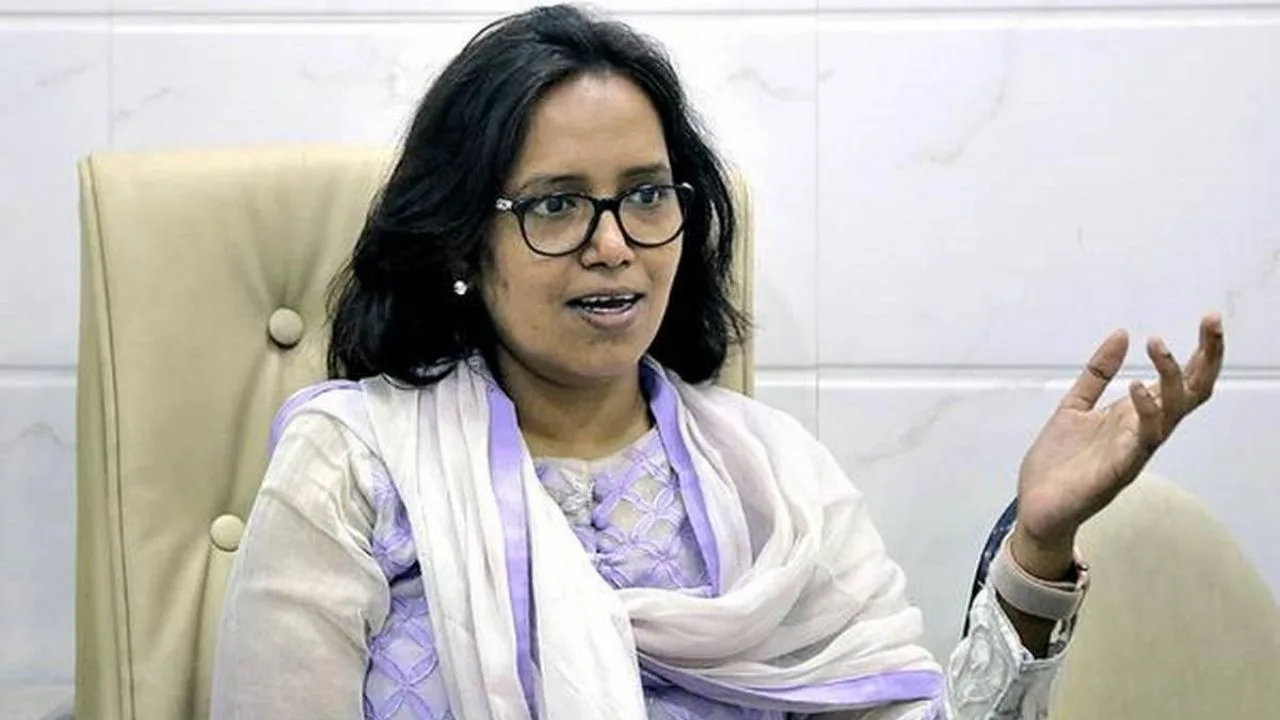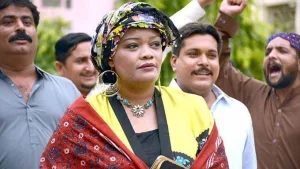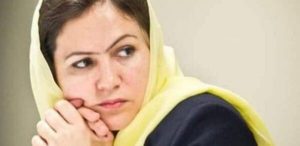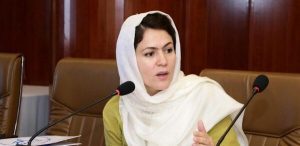“I Am The Education Minister Of Maharashtra Because Of Savitribai Phule”

For Varsha Eknath Gaikwad (45), Dharavi in Mumbai is much more than a constituency. She calls it home.
The 4 time Member of Legislative Assembly (MLA) from the Indian National Congress ( INC) from Dharavi- Asia’s biggest slum- has had her boots on the ground for the last 6 months in the efforts to contain the Covid-19 pandemic in one of the most densely populated slums in the world. From decentralising medical screening to streamlining the process of sending migrant workers back home, she has been in the middle of it all, personally overseeing the efforts.
As the education minister of Maharashtra, Varsha Gaikwad has also had to oversee the transition of education to online activities among other things.
As an ardent Phule-Ambedkarite, and only one of the 3 Dalit women MLAs in the Maharashtra state legislative assembly, she believes it is important to pave opportunities for women from marginalised communities and vest them with diverse ministerial portfolios.
“ If I am the education minister today, it is because of the path set by Savitribai and Jotiba Phule and Babasaheb Ambedkar”, she told Behanbox.
In a long conversation with BehanBox and Women for Politics, Varsha Gaikwad talks about her journey as a dalit woman in politics, her efforts to contain the pandemic in Dharavi and how the ideals of Babasaheb Ambedkar and Savitribai Phule guide her everyday in her politics.
This is part of a new series titled “Women, Power and Politics”, where we bring you conversations with radical and progressive women leaders from across the world. The first edition of the series features women political leaders from the South Asia region.
Tell us about your background, childhood and entry into politics.
I feel fortunate to be in politics today considering the background that I come from. We belong to the Dalit Magasvasrgiya community in Maharashtra and grew up with great financial difficulties, living in a big joint family. I am a first generation learner in my family who studied beyond the 10th grade and attended college and university. I have a masters degree in mathematics and also a Bachelor of Education (B.Ed). I was into academics before I entered politics
From what I remember, even as a 12 year old, I wanted to join politics. I used to go around Dharavi with my father, who was the Member of Legislative Assembly (MLA) and saw the immense goodwill he enjoyed among the people there. We were brought up amidst the ideology of Babasaheb Ambedkar, Krantijyoti Savitribai Phule and Mahatma Jotiba Phule. My father always taught us that our fight for justice and equality must continue in their footsteps, no matter what our professions were. As ardent believers in their ideologies, it was only natural that I saw politics as a platform for rewriting social justice as envisaged by them.
I am a living example of the anti Brahmanical patriarchal ideologies of Shahu-Ambedkar-Phule. My parents did not follow the usual tradition of pushing their sons to carry forward their political legacy. I remember that before the state assembly elections in 2004, my brother and I both went to the party office to interview for tickets. The Congress party chose me. So, I believe, apart from my parents, I appreciate the faith the party, Sonia Gandhi and Rahul Gandhi, put in a Dalit woman candidate.
I was only 27 when I was first elected an MLA for Dharavi in 2004. I remember so many asking me “But why politics? You are so well educated”. My answer then and it is now is that just as you cannot measure the depth of the ocean by sitting by the shore, you need to be part of the system to be able to change it.
You talk so passionately about the Phule-Ambedkar ideology that you are such an ardent believer and follower of. How have those ideals guided you in your politics and policymaking?
Krantijyoti Savitribai Phule started the first school for girls along with Fathima Begum in Pune in 1848. The regressive society pelted stones at them but they carried on with their mission in the face of all sorts of attacks. Her students achieved a great deal like Mukta Salve who became a writer.
So, today if a Varsha Gaikwad who studied in a Marathi medium school can become the education minister of Maharashtra, it is only because of the path laid out by Savitirbai and Jotiba Phule and Babasaheb Ambedkar. If she had not faced attacks and continued her protests against Brahmanical patriarchy, where would we be today?
The Phule couple adopted a child at a time when it was not the norm to do so. Not only that, they offered shelter and care for young kids, of widows and single women who were left destitute by society. They made provisions for water and food and more importantly respect and dignity for women, especially Dalit women.
These are the values that guide me in my work too. When I was the Women and Child welfare minister in 2014, I spoke to a lot of single women, especially sex workers directly and not through NGOs. This I believe is important- hearing from people directly.
Sex workers told me that they faced problems when school admission forms for their children asked for the father’s name and they could not provide this. They said how their kids were ridiculed or bullied. One of the first policies I made was to make the father’s name optional on the forms.
Similarly, I met a lot of transgender persons I met said that they faced a lot of difficulty in accessing welfare schemes and lack of recognition. We make policies for them but do not ensure simple things like documentation for them to be able to access that. I made policies on ration card access.
From Babasaheb, who is my idol, I learnt the principle of liberty, equality and fraternity- the basic ideals of our constitution. My heart aches when I see those basic values of the constitution being trampled upon today. As the education minister, I made the reading of the preamble of the Constitution mandatory in school assembly sessions and also explain it to children especially the values of equality and scientific temper,
What I learnt from all the three icons is the steadfastness of belief and the dedication and work needed to realise them.
Savitribai even died serving people during the plague where she was helping her son Dr. Yashwant.
Speaking of the pandemic, Dharavi was in news both for the rapid spread as well as the effective measures of containment. Today, ‘Dharavi Model’ has even become a case study. How was that achieved?
Dharavi is not just a constituency for me. It is my home.
So, when I first heard about the pandemic, I was scared for Dharavi. 1.2 million people live in the slum spread over 535 acres. 80% houses in Dharavi slum are under 100 sq ft. area, where 7-8 people live and conduct business. Most of them use common toilets. The alleys are so small that only one person can walk through at one time. How could we enforce physical distancing norms here?
When the first case was reported on the 31st March in Balikanagar, we quickly quarantined the area. But, it quickly spread in the 5 areas of the slums like kalyani nagar. Medinanagar, Yakub nagar, Social Nagar. By 1 April 2020, they were reporting 25 cases each day. That scared us. We began with implementing quarantine regulations in these 5 areas. The Brihanmumbai Municipal corporation(BMC) distributed masks widely.
We had to do toilet sanitisation but it had its own challenges. Anywhere between 50-350 people use the common toilets everyday. We had to sanitise them after every use. Neither did we have the human resource nor water to sanitise everytime. How were we to sanitise every alley and house. When we quarantined the 5 areas, we saw people going to toilets in other areas.
Then, there was the other problem of the stranded migrant workers. When the lockdown was announced on 25 March 2020, all the small hotels where the daily wage workers would eat an affordable Thali at Rs.30 were unavailable. So we had to make arrangements for food for them.
We started decentralised kitchens in around 19 different places to supply dry ration and cooked meals to the migrant workers during the lockdown.
What were the medical procedures and arrangements that were made in Dharavi, given the challenges, to contain the spread?
On the medical front, we knew we had to take a more proactive approach. So, we formed 10 teams of 23 doctors to quickly scale the screening processes in the entire area.
We also observed that people were taking medicines at home and only went to the doctors when they had breathing problems. They would come for oxygen and would go on to ventilator support.It was difficult for us to save these patients. So we asked the doctors to put a special emphasis on vulnerable categories like senior citizens, diabetic patients, those requiring dialysis, children and anybody they thought required attention. We arranged for many dispensaries with the help of local NGOs where screening could be done. A lot of associations and local doctors came forward to help with the screening in the dispensaries.
These doctors were then attached with the dedicated Covid-19 centre and hospitals. This was how we were able to reach more people quickly which helped us put people in isolation.
How did you deal with the migrant workers crisis during the lockdown period in Dharavi?
Migrant workers who come from across India to make a livelihood and build Mumbai were one of the most affected during the lockdown. They were anxious and getting restive about not finding their way back home. It was a difficult situation for them as the tenements were small and cramped.
I remember the first day when buses were arranged to take them back home. It was 8:30 in the morning and I had gone to see off the bus leaving for Rajasthan. There was a huge line outside the police station, where migrant workers were standing with 25 forms to fill before they could leave. This was cumbersome and had to change. So we asked all the NGOs of Dharavi to help them fill the forms along with our officers.
The procedure involved screening followed by a certificate to be issued by a doctor. At this point doctors were calling me to arrange police officers because they were surrounded by the workers. Police officers had to enforce the lockdown. So, when the central government team visited Dharavi, we told them that the process of obtaining medical certificates should be done away with and instead do an oximeter testing at the point of departure.
How did the people of Dharavi help in the efforts to contain Covid?
The entire credit for the success of containing the pandemic in Dharavi has to go to the people of the slum. You have to understand that, at the time, people could neither stay in their cramped tenements nor go outside for the fear of police crackdown.
The houses are so small that if a girl had to use the toilet, the male members would have to stand outside because she cannot use the common toilet. Even then, people kept their calm and followed all the directions given. They would voluntarily go to screening camps organized by us. This gave them the confidence for them to come forward and report symptoms. Some would call and say “Tai, I am suffering from a cold, what should I do”. We would get them tested and for positive cases we made hospital arrangements for them.
There were many people who were given the duties of cooking the meals, cleaning and working in the hospital. A lot of our workers passed away because of the disease.
What lessons do the efforts in Dharavi teach us, especially for public and elected representatives, while dealing with difficult situations such as the pandemic?
It is important to be on the ground and stand together at all times during the pandemic. That is something I was very particular about. There were many people working on the ground and as an elected representative, it was my job to support them. Varsha Gaikwad was not a single person. There was an entire team behind me- the BMC, police, medical authorities working along with the local representatives.
Dharavi was in the news for two months continuously. However today even the World Health Organisation (WHO) appreciated us for our efforts. It is important to recognise the entire team’s effort, because a pandemic of this scale needs efforts from all fronts to contain the spread.
Unfortunately, a lot of people are not here today. Today, Dharavi’s death rate is much lower than what it was before. We had also opened Dharavi upto some extent a month or so ago. Slowly Dharavi is coming back to normal. But the impact can be seen in our industry.
How has the industry been impacted in Dharavi?
Dharavi’s microfinance industry is worth Rs100 crores. Our industry – leather, garments, pottery, idli and farsan (snacks), recycling industry- has seen a massive impact. Until the social stigma associated with the pandemic diminishes, our industry will continue to suffer.For example, Idlis across Mumbai were made in Dharavi, but now people are skeptical about the hygeine conditions. The labour, such as domestic workers, security guards, taxi drivers or tempo drivers, is facing immense struggles. Earlier, GST and demonetisation ruined half of our businesses and now Corona had further exacerbated that.
Elected women representatives are few in number. Dalit women are even fewer. What institutional barriers do dalit women face and what can institutions do increase their chances in political participation?
You are absolutely right. In Maharashtra assembly, there are just 24 women MLAs, of which only 3 are Dalit women. For Dalit women, it is difficult to get elected repeatedly. This is why I argue for at least 50% quota for women in Parliament and state legislative assemblies.
Women have a greater advantage in that other women constituents have greater access to them. But getting more Dalit women into politics needs support from society and the political parties who have to give them tickets.
Secondly, women need to be given more diverse ministerial portfolios. Why do we get Women and child welfare, social justice or tribal affairs ministries? If Babasaheb Ambedkar can write the constitution of this nation, then why can I not be the education minister.
If Dalit women do not become ministers, how will we get a chance to make policy? We need opportunities to prove our capability. Our caste should not be the reason for exclusion from opportunities. Till the time this perception does not change, how will we progress?
As Dalit women, we have to prove ourselves over and over again to gain recognition and acceptance. There is always a different lens that people view you through when you come from a certain community. I may be here because of reservation but I have also worked hard for it. Otherwise , I would not have been elected four times.
Today, I am vocal about my thoughts and opinions, something I learnt from Babasaheb’s words. But, I also know it is very difficult for a woman, be it Mayawatiji or anyone else, to enter and grow in politics. Women are questioned over their character, judged harshly and accused of corruption. All this forces them to take a backseat.
My father’s words, when I came into politics, ring in my ears even today.
He told me “ Always think hard before you speak because we have a big name to uphold. And that is Bharat Ratna Dr Babasaheb Ambedkar.” So whatever I do, is to only glorify his name.
This is the second part in the series “Women, Power and Politics”. You can read the first part here and here.
[ With additional inputs from Shrishti Srivastava, Simran Kaur, Manmeen Kaur, Kashish Babbar, Ira Puranik]
We believe everyone deserves equal access to accurate news. Support from our readers enables us to keep our journalism open and free for everyone, all over the world.




